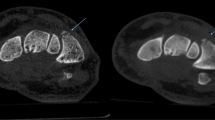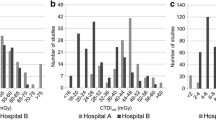Abstract
A multidetector computed tomography (MDCT) was installed in our department. Referral rates, examination protocols and detection rates of abnormal findings in CT examinations for cervical spine trauma 6 months before and 6 months after MDCT installation were compared to look for changes in practice. Retrospective analysis of all CT cervical spine examinations in patients with multiple trauma over two contiguous 6-month periods: from July 2003 to December 2003 (helical CT) and from January 2004 to June 2004 (MDCT). Variables recorded were number of CT examinations performed, scan plane coverage and traumatic abnormalities detected. Phantom dosimetry measurements for cervical spine examination in both helical CT and MDCT were compared. One hundred and fifty four patients underwent cervical spine CT during these periods. Helical CT period: of 91 patients undergoing CT cervical spine examination for trauma, 65 (71%) were complete cervical examinations and 26 (29%) were level-specific examinations. Eight patients (9%) had cervical spine fracture, six of which were apparent on radiographs. Dose estimations for thyroid, lens and breast were 24.76, 1.86 and 0.21 mGy, respectively, for complete cervical spine examinations. MDCT period: of 63 patients who underwent CT cervical spine examination for trauma, 61 (97%) were complete examinations and 2 (3%) were level-specific examinations. Six patients (11%) had cervical spine fracture, three of which were apparent on radiographs. Dose estimations for thyroid, lens and breast were 75.8, 9.7 and 0.7 mGy, respectively, for complete cervical spine examinations, which were notably higher than those for helical CT. After installation of MDCT, clinical requests for complete examination of the cervical spine following trauma increased. This changing trend resulted in a significantly higher radiation dose to thyroid, lens and breast.




Similar content being viewed by others
References
Woodring JF, Lee C (1993) Limitation of cervical radiography in the evaluation of acute cervical trauma. J Trauma 34:32–39
Nunez DB, Ahmed AA, Coin CG et al (1994) Clearing the cervical spine in multiple trauma victims: a time-effective protocol using helical CT. Emergency Radiol 1:273–278
Kirschenbaum KJ, Naimpalli SR, Fantus R, Cavallino RP, Crystal GJ (1990) Unsuspected upper cervical spine fractures associated with significant head trauma: role of CT. J Emergency Med 8:183–198
Hanson JA, Blackmore CC, Man FA, Wilson AJ (2000) Cervical spine injury. A clinical decision rule to identify high-risk patients for helical CT screening. AJR 179:713–717
Blackmore CC, Emerson SS, Man FA, Koepsell TD (1999) Cervical spine imaging in patients with trauma: determination of fracture risk to optimize use. Radiology 211:759–765
deGonzalez AB, Darrby S (2004) Risk of cancer from diagnostic X ray: estimates for the UK& 14 other countries. Lancet 363:34–351
Author information
Authors and Affiliations
Corresponding author
Rights and permissions
About this article
Cite this article
Chan, P., Antonio, G., Griffith, J. et al. Computed tomography for cervical spine trauma. The impact of MDCT on fracture detection and dose deposition. Emerg Radiol 11, 286–290 (2005). https://doi.org/10.1007/s10140-005-0407-2
Received:
Accepted:
Published:
Issue Date:
DOI: https://doi.org/10.1007/s10140-005-0407-2




